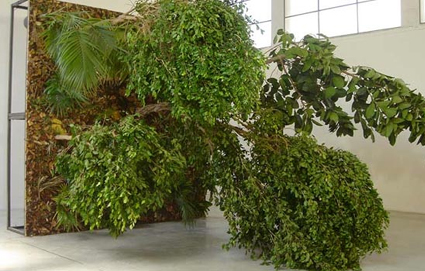“Radical Nature” is an earth summit in the form of an art exhibition. Green thoughts abound, albeit not in a green shade but in the brutalist concrete bunker of the Barbican Art Gallery – an intermittently apt space, as it turns out, for these assembled shards of eco-polemic, organic architecture and Land Art experiment.
Ironic recontextualisation (as the art jargon has it) is a tactic favoured by many of the selected artists. The show opens with the spectacle of Mark Dion’s taxidermised wolf, complete with a reconstructed chunk of its natural habitat, perched on a car-trailer, stranded on the gallery floor. A sardonic comment on man’s habitually blithe inhumanity towards the natural world may be inferred. Nearby, Anya Gallaccio has painstakingly reassembled a felled and axe-dismembered silver birch tree. Pegged and stapled together, its reformed trunk and branches reach up towards what little sunshine filters through the Barbican’s skylights. But its leaves are telltale withered, dry as paper. Gallaccio’s work is poignant, a parable told in fragments. Complex organisms cannot be reconstructed in kit-form.
While Gallaccio’s dead tree might stand for an entire micro-system, Henrik Hakansson’s Fallen Forest actually is a displaced microsystem, or at least a fragment of one, alienated to the same bare Barbican mezzanine. The piece consists of a 16-square-metre fragment of rainforest, kept alive for the duration of the show by ingenious means of irrigation, but flung weirdly on its side. Protruding obscenely from a panel of suspended earth, leaves and tendrils trail on the floor like the outflung arms of a fallen body. This visibly wilting cross-section of a disappearing world is another prompt to morbid contemplation.
Nearby, Newton Harrison and Helen Mayer Harrison’s Full Farm flashes suddenly back to a more innocent era of eco-optimism. Originally created in the early 1970s, the work is...


